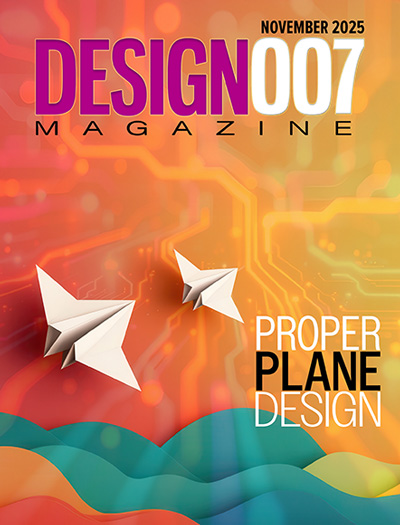-

- News
- Books
Featured Books
- design007 Magazine
Latest Issues
Current Issue
Designing Proper Planes
Without planes, designers would have to create thousands of traces to accomplish the same objectives. Power planes provide low impedance and stable power, and ground planes stabilize reference voltage, improve thermal performance, and help preclude EMI issues.

Power Integrity
Current power demands are increasing, especially with AI, 5G, and EV chips. This month, our experts share “watt’s up” with power integrity, from planning and layout through measurement and manufacturing.

Signal Integrity
If you don’t have signal integrity problems now, you will eventually. This month, our expert contributors share a variety of SI techniques that can help designers avoid ground bounce, crosstalk, parasitic issues, and much more.
- Articles
- Columns
- Links
- Media kit
||| MENU - design007 Magazine
Cadence Introduces EMX Designer
April 14, 2023 | Cadence Design Systems, Inc.Estimated reading time: 2 minutes
Cadence Design Systems, Inc. announced the new Cadence® EMX® Designer, a passive device synthesis and optimization technology that delivers, in split seconds, design rule check (DRC)-clean parametric cells (PCells) and accurate electromagnetic (EM) models of passive devices, such as inductors, transformers, T-coils and more. Seamlessly integrated with the Cadence Virtuoso® ADE Product Suite, the EMX Designer solution offers more than 10X faster synthesis times, with significant productivity gains versus other solutions.
The EMX Designer solution lets customers rapidly synthesize DRC-clean passive devices at a touch of a button, based on electrical and geometrical requirements. With unparalleled flexibility, EMX Designer PCells can easily be modified to meet the designers’ exact layout requirements, utilizing a long list of options from a user-friendly interface inside the Virtuoso platform. When used with the EMX 3D Planar Solver, the industry’s gold-standard electromagnetic modeling engine, the EMX Designer solution ensures the accuracy of generated models. The seamless integration with the Virtuoso platform offers users various options for plotting and appending results.
“pSemi evaluated the Cadence EMX Designer solution as we were interested in automating the passive device creation and optimization process for our proprietary PDKs,” said John Sung, Vice President of Engineering Infrastructure at pSemi. “EMX Designer fully met our requirements for PCell flexibility, speed and accuracy. It is seamlessly integrated into the Cadence design flow and will improve the productivity of our design teams.”
“The new EMX Designer solution adds key technology to our leading Custom IC design flow, delivering the most flexible passive-device PCells in record-breaking time while also enabling significant productivity gains,” said Tom Beckley, senior vice president and general manager, Custom IC & PCB Group at Cadence. “We are pleased to offer our customers an expanded, complete, highly differentiated and efficient IC design platform that addresses the early stages of the design all the way through to signoff and closure.”
“Using Cadence’s new EMX Designer solution, our team was able to improve productivity and reduce design cycle times,” said Peter Gammel, CEO, Ubilite. “We managed to synthesize passive devices with better performance, and at the same time, save 20% silicon area for the advanced process nodes we use with the new solution. EMX Designer offers us a versatile library of passive devices, delivering extremely accurate results across all process nodes at incredibly fast speeds.”
The EMX Designer solution seamlessly interfaces with Cadence EMX 3D Planar Solver and further supports the Cadence Intelligent System Design™ strategy, enabling system-on-chip (SoC) design excellence and system innovation.
Testimonial
"Your magazines are a great platform for people to exchange knowledge. Thank you for the work that you do."
Simon Khesin - Schmoll MaschinenSuggested Items
PCB Design Software Market to Hit $12.11 Billion by 2033, Growing at a CAGR of 13.77%
11/14/2025 | Globe NewswireThe PCB Design Software Market Size was valued at USD 4.32 Billion in 2025E and is expected to reach USD 12.11 Billion by 2033 and grow at a CAGR of 13.77% over the forecast period 2026-2033.
Zuken Opens Call for Papers for ZIW Americas 2026
11/13/2025 | ZukenZuken USA, Inc. opens the Zuken Innovation World (ZIW) Americas 2026 Call for Papers to help engineers, managers, and leaders showcase proven results and advance industry best practices. ZIW is Zuken USA’s semi-annual Digital Engineering conference on electrical and electronic design for engineers, managers, and industry leaders. It focuses on current practices and emerging trends with practical takeaways.
Innatera Signs Joya as ODM Customer, Bringing Neuromorphic Edge AI into Everyday Connected Products
11/13/2025 | PRNewswireInnatera, the leader in brain-like neuromorphic computing for ultra-low-power intelligence at the sensor edge, today announced that Xiamen Joyatech Co., Ltd. has become its first Original Design Manufacturer (ODM) customer.
Advanced Electronics Packaging Digest: Third Issue Arrives November 17
11/12/2025 | I-Connect007The third issue of Advanced Electronics Packaging Digest launches Monday, November 17. This issue continues AEPD’s mission to deliver forward-looking analysis and insider perspectives on the technologies reshaping advanced electronics packaging. Among the highlights is a review of IMPACT 2025, where discussions on component-to-system-level integration took center stage as experts explored the challenges and breakthroughs driving advanced packaging technologies.
Electronic Design Automation (EDA) Market Size to Reach $811.1 Million by 2030
11/12/2025 | PRNewswireThe Global Electronic Design Automation (EDA) Market was estimated to be worth USD 541 Million in 2023 and is forecast to a readjusted size of USD 811.1 Million by 2030 with a CAGR of 6.4% during the forecast period 2024-2030.


